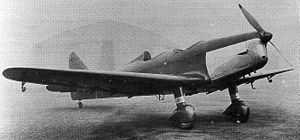Parnall 382
| Parnall 382 | |
|---|---|
 | |
| Role | Two-seat monoplane trainer |
| National origin | United Kingdom |
| Manufacturer | Parnall Aircraft Ltd |
| Designer | Basil Henderson |
| First flight | 1939 |
| Number built | 1 |
| Developed from | Parnall Heck |
The Parnall 382 was a 1930s British single-engined monoplane trainer aircraft with two open cockpits, designed and developed by Parnall Aircraft Ltd.
Design and development
The Parnall 382 was designed to meet UK Air Ministry Specification T.1/37 for an 'ab initio' trainer, and was also known as the Parnall Heck III. Its competitors were the Heston T.1/37 and the Miles M.15. The Airspeed AS.36, General Aircraft GAL.32 and Percival P.20 were also proposed against specification T.1/37, but not accepted or built. None of the designs was selected for production orders; it has been suggested[1] that the required performance could not be achieved within the constraints of the Specification.
Construction was primarily wooden, with plywood-skinned spruce frames. The cantilever oleo-pneumatic fixed main undercarriage legs were faired with spats. The undercarriage, tail unit and outer wing panels were adapted from the Parnall Heck 2C. The propeller was a de Havilland fixed-pitch type. Student and tutor sat in open, tandem cockpits, but the rear cockpit was later enclosed.[2][3]
Operational history
One example of the Parnall 382 was built by Parnall Aircraft Ltd as a private venture project. The first flight was by G.A.C Warren at Yate Aerodrome in February 1939, with B conditions registration J1. In September 1939 it was registered G-AFKF. In June 1941, as the Parnall Heck III, it was allocated serial R9138 under contract 23979/39.[4] In trials at the Aeroplane & Armament Experimental Establishment (A&AEE) at Martlesham Heath, it was assessed as pleasant to fly and generally good as a trainer. Notwithstanding a few modifications, no order was forthcoming, and it was SOC (struck off charge) on 5 March 1943. It was allocated the serial 3600M[5] and ended its days as an Air Training Corps instructional airframe at Jones' West Monmouth School, Pontypool.
Specifications
Data from British Civil Aircraft Since 1919[2]
General characteristics
- Crew: 2
- Length: 28 ft 8 in (8.74 m)
- Wingspan: 33 ft 6 in (10.21 m)
- Height: 7 ft 9 in (3.66 m)
- Wing area: 155 ft² (14.39 m²)
- Airfoil: BH5
- Empty weight: 1,655 lb (751 kg)
- Loaded weight: 2,450 lb (1,112 kg)
- Powerplant: 1 × de Havilland Gipsy Queen I 6-cylinder inverted inline, 200 hp (149 kW)
- Propellers: fixed pitch propeller
Performance
- Maximum speed: 155 mph (248 km/h)
- Cruise speed: 135 mph (216 km/h)
Notes
References
| Wikimedia Commons has media related to Parnall 382. |
- Halley, James J. (1980), Royal Air Force Aircraft R1000-R9999, UK: Air-Britain, ISBN 0-85130-082-0
- Jackson, A.J. (1974), British Civil Aircraft Since 1919 Volume 3, UK: Putnam & Company Ltd, p. 91, ISBN 0-370-10014-X
- Revell, D.S. (1978), Under B Conditions, UK: Merseyside Aviation Society, ISBN 0-902420-24-0
- Lukins, A.H.; Russell, D.A. (1945), The Book of Miles aircraft, Leicester: Harborough
| ||||||||||||||||||||||